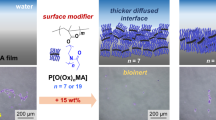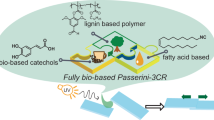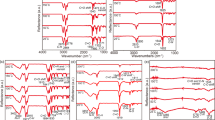Abstract
One of the super engineering plastics, poly(ether ether ketone) (PEEK), was functionalized by photoinduced self-initiated graft polymerization of various methacrylate monomers. Anionic, cationic, zwitterionic, nonionic hydrophilic, and nonionic hydrophobic polymer layers were formed onto PEEK substrates. Physical and chemical surface characterizations of the resultant polymer-grafted PEEK substrates were performed through measurements of their surface free energies and ζ potentials. The values of these parameters varied in the ranges of 39–71 mJ/m2 and −69 to 46 mV, respectively. These parameters reflected the chemical structures of the grafted polymers. To understand the effects of these surface parameters on cell adhesion behavior at the substrate surface, the amount of fibronectin adsorbed on the plasma-contacting surface and the density of fibroblast cells adhered to the surface were determined. The adherent cell density showed a good linear correlation with the amount of fibronectin adsorbed on the plasma-contacting surface. The polymer surface with zero ζ potential showed a lower adsorbed fibronectin density. Both anionic and cationic polymer layers had increased cell adhesion compared with that on the original PEEK substrate, whereas the zwitterionic polymer layers significantly prevented cell adhesion. In conclusion, grafting zwitterionic polymers onto a PEEK substrate is anticipated to be useful in the development of a biomedical PEEK substrate.
This is a preview of subscription content, access via your institution
Access options
Subscribe to this journal
Receive 12 print issues and online access
$259.00 per year
only $21.58 per issue
Buy this article
- Purchase on Springer Link
- Instant access to full article PDF
Prices may be subject to local taxes which are calculated during checkout








Similar content being viewed by others
Change history
06 April 2020
An amendment to this paper has been published and can be accessed via a link at the top of the paper.
References
Lu SX, Cebe P, Capel M. Thermal stability and thermal expansion studies of PEEK and related polyimides. Polymer. 1996;37:2999–3009.
Pascual A, Toma M, Tsotra P, Grob M. On the stability of PEEK for short processing cycles at high temperatures and oxygen-containing atmosphere. Polym Deg Stab. 2019;165:161–9.
Rings M, Lanzutti A, Bracco P, Fedrizzi L. Wear behavior of medical grade PEEK and CFR PEEK under dry and bovine serum conditions. Wear. 2018;408–409:86–95.
Toth JM, Wang M, Estes BT, Scifert JL, Seim HB 3rd, Turner AS. Polyetheretherketone as a biomaterial for spinal applications. Biomaterials. 2006;27:324–34.
Kurtz SM, Devine JN. PEEK biomaterials in trauma, orthopedic, and spinal implants. Biomaterials. 2007;28:4845–69.
Mishra S, Chowdhary R. PEEK materials as an alternative to titanium in dental implants: a systematic review. Clin Implant Dent Relat Res. 2019;21:208–22.
Franchina NL, Mccarthy TJ. Surface modifications of poly(ether ether ketone). Macromolecules. 1991;24:3045–9.
Ameen AP. An investigation of the surface chemical homogeneity of plasma oxidised poly(ether etherketone). Polym Degrad Stab. 1996;51:179–84.
Riveiro A, Soto R, Comesana R, Boutinguiza M, del Val, Quintero F, et al. Laser surface modification of PEEK. Appl Surf Sci. 2012;258:9437–42.
Tsou HK, Hsieh PY, Chi MH, Chung CJ, He JL. Improved osteoblast compatibility of medical-grade polyetheretherketone using arc ionplated rutile/anatase titanium dioxide films for spinal implants. J Biomed Mater Res Part A. 2012;100A:2787–92.
Kunomura S, Iwasaki Y. Immobilization of polyphosphoesters on poly(ether ether ketone) (PEEK) for facilitating mineral coating. J Biomater Sci Polym Ed. 2019;30:861–76.
Fristrup CJ, Jankova K, Hvilsted S. Hydrophilization of poly(ether ether ketone) films by surface-initiated atom transfer radical polymerization. Polym Chem. 2010;1:1696–701.
Yameen B, Alvarez M, Azzaroni O, Jonas U, Knoll W. Tailoring of poly(ether ether ketone) surface properties via surface-initiated atom transfer radical polymerization. Langmuir. 2009;25:6214–20.
Kyomoto M, Ishihara K. Self-initiated surface graft polymerization of 2-methacryloyloxyethyl phosphorylcholine on poly(ether ether ketone) by photoirradiation. ACS Appl Mater. Interface. 2009;1:537–42.
Kyomoto M, Moro T, Takatori Y, Kawaguchi H, Nakamura K, Ishihara K. Self-initiated surface grafting with poly(2-methacryloyloxyethyl phosphorylcholine) on poly(ether-ether-ketone). Biomaterials. 2010;31:1017–24.
Kyomoto M, Moro T, Yamane S, Hashimoto M, Takatori Y, Ishihara K. Poly(ether-ether-ketone) orthopedic bearing surface modified by self-initiated surface grafting of poly(2-methacryloyloxyethyl phosphorylcholine). Biomaterials. 2013;34:7829–39.
Kyomoto M, Moro T, Yamane S, Watanabe K, Takatori Y, Tanaka S. Ishihara. Smart PEEK modified by self-initiated surface graft polymerization for orthopedic bearings. Reconstr Rev. 2014;4:36–45.
Tateishi T, Kyomoto M, Kakinoki S, Yamaoka T, Ishihara K. Reduced platelets and bacteria adhesion on poly(ether ether ketone) by photoinduced and self-initiated graft polymerization of 2-methacryloyloxyethyl phosphorylcholine. J Biomed Mater Res A. 2014;102:1342–9.
Shiojima T, Inoue Y, Kyomoto M, Ishihara K. High-efficiency preparation of poly(2-methacryloyloxyethyl phosphorylcholine) grafting layer on poly(ether ether ketone) by photoinduced and self-initiated graft polymerization in an aqueous solution in the presence of inorganic salt additives. Acta Biomater. 2016;40:38–45.
Yamane S, Kyomoto M, Moro T, Hashimoto M, Takatori Y, Tanaka S, et al. Wear resistance of poly(2-methacryloyloxyethyl phosphorylcholine)-grafted carbon fiber reinforced poly(ether ether ketone) liners against metal and ceramic femoral heads. J Biomed Mater Res B Appl Biomater. 2018;106:1028–37.
Kambe Y, Mahara A, Tanaka H, Kakinoki S, Fukazawa K, Liu Y, et al. Short-term evaluation of thromboresistance of a poly(ether ether ketone) (PEEK) mechanical heart valve with poly(2-methacryloyloxyethyl phosphorylcholine) (PMPC)-grafted surface in a porcine aortic valve replacement model. J Biomed Mater Res A. 2019;107:1052–63.
Ishihara K. Highly lubricated polymer interfaces for advanced artificial hip joint through biomimetic design. Polym J. 2015;47:585–97.
Kawasaki Y, Iwasaki Y. Surface modification of poly(ether ether ketone) with methacryloyl-functionalized phospholipid polymers via self-initiation graft polymerization. J Biomater Sci Polym Ed. 2014;25:895–906.
Yousaf A, Farrukh A, Oluz Z, Tuncel E, Duran H, Doğan SY, et al. UV-light assisted single step route to functional PEEK surfaces. React Funct Polym. 2014;83:70–5.
Chouwatat P, Hirai T, Higaki K, Higaki Y, Sue HJ, Takahara A. Aqueous lubrication of poly(etheretherketone) via surface-initiated polymerization of electrolyte monomers. Polymer. 2017;116:549–55.
Liu S, Zhu Y, Gao H, Ge P, Ren K, Gao J, et al. One-step fabrication of functionalized poly(etheretherketone) surfaces with enhanced biocompatibility and osteogenic activity. Mater Sci Eng C Mater Biol Appl. 2018;88:70–8.
Amdjadi P, Nojehdehian H, Najafi F, Ghasemi A, Seifi M, Dashtimoghadam E, et al. Ultraviolet-induced surface grafting of octafluoropentyl methacrylate on polyether ether ketone for inducing antibiofilm properties. J Biomater Appl. 2017;32:3–11.
Zhao X, Xiong D, Wang K, Wang N. Improved biotribological properties of PEEK by photo-induced graft polymerization of acrylic acid. Mater Sci Eng C Mater Biol Appl. 2017;75:777–83.
Zheng Y, Liu L, Ma Y, Xiao L, Li Y. Enhanced osteoblasts responses to surface-sulfonated polyetheretherketone via a single-step ultraviolet-initiated graft polymerization. Ind Eng Chem Res. 2018;57:10403–10.
Zheng Y, Liu L, Xiao L, Zhang Q, Liu Y. Enhanced osteogenic activity of phosphorylated polyetheretherketone via surface-initiated grafting polymerization of vinylphosphonic acid. Colloids Surf B Biointerfaces. 2019;173:591–8.
Oai K, Inoue Y, Nakao A, Fukazawa K, Ishihara K. Antibacterial effect of nanometer-size grafted layer of quaternary ammonium polymer on poly(ether ether ketone) substrate. J Appl Polym Sci. 2020;e49088. https://doi.org/10.1002/app.49088.
Ishihara K, Ueda T, Nakabayashi N. Preparation of phospholipid polymers and their properties as polymer hydrogel membranes. Polym J. 1990;22:355–60.
Bangera AE, Appaiah K. A conditional justification for the determination of surface energy of solids using contact angle methods. Mater Chem Phys. 2019;234:168–71.
Ishihara K, Ziats NP, Tierney BP, Nakabayashi N, Anderson JM. Protein adsorption from human plasma is reduced on phospholipid polymers. J Biomed Mater Res. 1991;25:1397–407.
Murakami D, Kobayashi M, Higaki Y, Jinnai H, Takahara A. Swollen structure and electrostatic interactions of polyelectrolyte brush in aqueous solution. Polymer. 2016;98:464–9.
Ishihara K, Mu M, Konno T, Inoue Y, Fukazawa K. The unique hydration state of poly(2-methacryloyloxyethyl phosphorylcholine). J Biomater Sci Polym Ed. 2017;28:884–99.
Cappelletti G, Ardizzone S, Meroni D, Soliveri G, Ceotto M, Biaggi C, et al. Wettability of bare and fluorinated silanes: a combined approach based on surface free energy evaluations and dipole moment calculations. J Colloid Interface Sci. 2013;389:284–91.
Pereni CI, Zhao Q, Liu Y, Abel E. Surface free energy effect on bacterial retention. Colloids Surf B Biointerfaces. 2006;48:143–7.
Kobayashi M, Terayama Y, Yamaguchi H, Terada M, Murakami D, Ishihara K, et al. Wettability and antifouling behavior on the surfaces of superhydrophilic polymer brushes. Langmuir. 2012;28:7212–22.
Ishihara K. Blood-compatible surfaces with phosphorylcholine-based polymers for cardiovascular medical devices. Langmuir. 2019;35:1778–87.
Ishihara K, Nomura H, Mihara T, Kurita K, Iwasaki Y, Nakabayashi N. Why do phospholipid polymers reduce protein adsorption. J Biomed Mater Res. 1998;39:323–30.
Sakata S, Inoue Y, Ishihara K. Quantitative evaluation of interaction force between functional groups in protein and polymer brush surfaces. Langmuir. 2014;30:2745–51.
Spriano S, Sarath Chandra V, Cochis A, Uberti F, Rimondini L, Bertone E, et al. How do wettability, zeta potential and hydroxylation degree affect the biological response of biomaterials? Mater Sci Eng C Mater Biol Appl. 2017;74:542–55.
Hao L, Fu X, Li T, Zhao N, Shi X, Cui F, et al. Surface chemistry from wettability and charge for the control of mesenchymal stem cell fate through self-assembled monolayers. Colloids Surf B Biointerfaces. 2016;148:549–56.
Tzoneva R, Faucheux N, Groth T. Wettability of substrata controls cell-substrate and cell-cell adhesions. Biochim Biophys Acta. 2007;1770:1538–47.
Arima Y, Iwata H. Effect of wettability and surface functional groups on protein adsorption and cell adhesion using well-defined mixed self-assembled monolayers. Biomaterials. 2007;28:3074–82.
Ishihara K, Kitagawa T, Inoue Y. Initial cell adhesion on well-defined surface by polymer brush layers with varying chemical structures. ACS Biomater Sci Eng. 2015;1:103–9.
Acknowledgements
This research was supported in part by the S-innovation Research Program for the “Development of the biofunctional materials for realization of innovative medicine”, Japan Agency for Medical Research and Development (AMED).
Author information
Authors and Affiliations
Corresponding author
Ethics declarations
Conflict of interest
The authors declare that they have no conflict of interest.
Additional information
Publisher’s note Springer Nature remains neutral with regard to jurisdictional claims in published maps and institutional affiliations.
Supplementary information
Rights and permissions
About this article
Cite this article
Ishihara, K., Yanokuchi, S., Fukazawa, K. et al. Photoinduced self-initiated graft polymerization of methacrylate monomers on poly(ether ether ketone) substrates and surface parameters for controlling cell adhesion. Polym J 52, 731–741 (2020). https://doi.org/10.1038/s41428-020-0318-9
Received:
Revised:
Accepted:
Published:
Issue Date:
DOI: https://doi.org/10.1038/s41428-020-0318-9
This article is cited by
-
Liquid-like polymer lubricating surfaces: Mechanism and applications
Nano Research (2024)
-
Near-ambient pressure X-ray photoelectron spectroscopy for a bioinert polymer film at a water interface
Polymer Journal (2021)
-
Poly[oligo(2-ethyl-2-oxazoline) methacrylate] as a surface modifier for bioinertness
Polymer Journal (2021)



